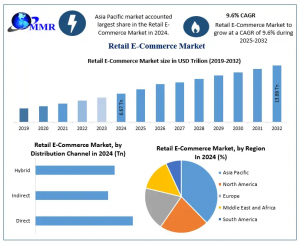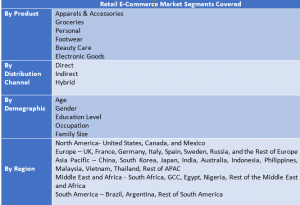Retail E-Commerce Market Hits USD 6.67 Trillion in 2024 – Growth & Trends Forecast
As mobile commerce, AI and social shopping reshape the Retail E-commerce Market, companies must innovate strategically to meet evolving consumer expectations.
Retail E-commerce Market is witnessing rapid transformation as digital adoption, mobile commerce, and innovative delivery models reshape how consumers shop worldwide. Rising smartphone penetration and internet accessibility have made online platforms more convenient and competitive, with mobile devices generating 57% of global e-commerce sales in 2024, projected to reach 59% in 2025. Shoppers increasingly demand fast, transparent, and seamless experiences, with 74% expecting delivery within two days and 92% valuing delivery-window transparency.
Gain Valuable Insights – Request Your Complimentary Sample Now @ https://www.maximizemarketresearch.com/request-sample/198871/
Segmented by product, distribution channel, and end-user, the market covers apparel & accessories, electronics, beauty care, groceries, footwear, and home décor, while B2C, B2B, and C2C models drive varied consumer engagement. Online marketplaces dominate distribution, though social-commerce platforms and brand-owned websites are gaining traction, particularly in developing regions. Globally, the Asia-Pacific region contributes over 55% of e-commerce transactions, while North America and Europe maintain significant digital retail penetration.
From Swipe to Doorstep: Key Forces Shaping the Retail E-commerce Market’s Next Phase
The Retail E-commerce Market is rapidly evolving thanks to several powerful catalysts. With consumers able to compare prices across multiple platforms and online retailers enjoying lower overheads than physical stores, price competitiveness is pushing online retail growth. Growth in smartphone adoption and mobile internet usage is particularly significant: mobile devices now generate around 57% of global ecommerce sales in 2024, with estimates rising to 59% in 2025. Superior delivery infrastructure and strong e-commerce logistics are also fundamental drivers of the Retail E-commerce Market’s expansion. For example, 74% of online shoppers expect delivery within two days, and 92% consider delivery-window transparency critical when choosing an online retailer.
On the flip side, the Retail E-commerce Industry faces headwinds tied to security, regulatory complexity and trust-building among consumers. Mobile commerce alone reshapes omnichannel expectations by 2025 mobile is projected to drive 78% of ecommerce traffic and 66% of all online orders. Shoppers increasingly expect seamless experiences, fast delivery and transparent pricing making operational excellence a must for companies aiming to capture share. Nonetheless, with mobile shopping, influencer-driven marketing and cross-border opportunities gaining traction, the Retail E-commerce Market is poised to redefine how, when and where consumers shop.
Expanding Across Products, Platforms, and Consumer Models
The Retail E-commerce Market is broadly segmented by product type, platform and business model, reflecting the industry’s diverse consumer base and rapid digital evolution. By product type, the Retail E-commerce Market by Product includes apparel & accessories, electronics, beauty & personal care, groceries, footwear and home décor which collectively account for a major share of online retail transactions. According to recent data, pure-marketplace models held over 58.7% of the global retail e-commerce share in 2024. The Retail E-commerce Market by Type further comprises pure marketplaces, hybrid marketplaces and direct-to-consumer (D2C) platforms, each offering unique value propositions to customers seeking convenience and brand authenticity.
By Retail E-commerce Market by Distribution Channel, online marketplaces dominate, while growing traction is seen from social-commerce platforms and brand-owned websites, particularly in developing economies. Meanwhile, the Retail E-commerce Market by End-User includes B2C, B2B and C2C segments the B2B segment captured over 63.6% share in 2024. As consumers continue to shift from physical retail to digital-first experiences, these segments collectively drive innovation, competition and personalization across the global Retail E-commerce Industry.
Feel free to request a complimentary sample copy or view a summary of the report @ https://www.maximizemarketresearch.com/request-sample/198871/
Key Geographies Driving the Global Retail E-commerce Market
The global Retail E-commerce Market displays strong regional variation in adoption and digital maturity. In North America, e-commerce accounted for approximately 16.2% of total retail sales in the U.S. during Q3 2024, reflecting a well-established online retail infrastructure. Meanwhile, Europe continues to experience steady digital retail penetration, supported by increasing mobile commerce adoption and cross-border shopping preferences. The Retail E-commerce Market Asia-Pacific dominates globally, contributing over 55% of total e-commerce transactions in 2024, driven by rapid smartphone adoption and high internet penetration in countries such as China, India, and Indonesia.
Emerging regions like Latin America and the Middle East & Africa are also witnessing accelerating online retail adoption, supported by improving digital payment infrastructure. Notably, mobile commerce sales exceeded US $2 trillion globally in 2024, emphasizing the growing importance of mobile-first retail strategies. As companies adapt to regional consumer behavior, localized marketing, flexible payment solutions, and sustainable logistics models remain critical to succeeding in the Global Retail E-commerce Market.
Recent Developments in Retail E-Commerce Market602
Zepto Secures $450 Million Funding Amid Rapid Growth
On October 16, 2025, Indian quick commerce platform Zepto announced a $450 million funding round, elevating its valuation to $7 billion. This investment underscores the surging demand for ultra-fast delivery services in India, where the quick commerce market is projected to triple by 2028. Zepto's expansion includes over 45,000 products, ranging from groceries to electronics, and aligns with the broader Retail E-commerce Market's shift towards hyper-local delivery models.
Walmart Integrates ChatGPT for Conversational Shopping
In a strategic move announced in October 2025, Walmart partnered with OpenAI to integrate ChatGPT into its retail operations. This collaboration enables customers to make purchases directly through chatbot conversations, enhancing the shopping experience. The integration reflects a growing trend in the Retail E-commerce Market towards conversational commerce, catering to the increasing consumer preference for AI-driven shopping assistance.
Key Trends Shaping the Retail E-commerce Market
Mobile Commerce Dominance: Mobile devices now account for 57% of global e-commerce sales in 2024, highlighting the increasing importance of mobile-first strategies. Retailers are optimizing apps and websites for seamless Retail E-commerce Market experiences, enhancing user engagement and conversion rates.
AI and Social Commerce Integration: Brands are leveraging AI-powered personalization and social media platforms to drive sales, improve recommendations, and boost customer satisfaction. This trend underscores the growing role of technology and innovation in the Retail E-commerce Industry, shaping how consumers discover and purchase products online.
Competitive Landscape: Dominance, Disruption, and Innovation in Retail E-commerce
The Retail E-commerce Market is characterized by intense competition among established giants and emerging disruptors. In the United States, Amazon leads with a commanding 37.6% market share, followed by Walmart at 6.4%, Apple at 3.6%, and eBay at 3%. Globally, Amazon's influence extends beyond the U.S., with significant market shares in regions like Europe and Asia-Pacific. In India, Blinkit has emerged as a leader in the quick commerce sector, securing over 50% market share in the 10-minute delivery segment, outpacing competitors such as Zepto and Swiggy's Instamart.
The competitive dynamics are further shaped by the rise of online marketplaces, projected to reach a total Gross Merchandise Value (GMV) of $3.832 trillion by the end of 2024. This growth is driven by mobile commerce, social commerce, and the increasing importance of fast delivery services. Retailers are investing in technology, logistics, and customer experience to maintain a competitive edge in this rapidly evolving market.
Key Players in Retail E-Commerce Market
North America
com Inc. (USA)
Apple Inc. (USA)
Target (USA)
eBay Inc. (USA)
Groupon Inc. (USA)
Walmart Inc. (USA)
Albertsons Companies, Inc. (USA)
Best Buy (USA)
BigCommerce (USA)
Zappos (USA)
Europe
Otto (GmbH & Co KG) (Germany)
Inter IKEA Systems B.V. (Netherlands)
Asos (UK)
Asia-Pacific
Alibaba Group Holding Limited (China)
Taobao (China)
Coupang Corp. (South Korea)
South America
B2W Companhia Digital (Brazil)
Analyst Recommendation:
Analysts recommend that companies in the Retail E-commerce Market focus on mobile-first strategies, AI-driven personalization, and fast delivery infrastructure to capture emerging opportunities. Investing in social commerce, omnichannel experiences, and secure digital payments will enhance customer engagement, expand market share, and strengthen competitive positioning in the rapidly evolving Retail E-commerce Industry.
FAQs of Retail E-commerce Market
Q1: What is the Retail E-commerce Market?
The Retail E-commerce Market encompasses the sale of goods and services through online platforms, including marketplaces, brand websites, and social commerce channels.
Q2: Which region leads the global Retail E-commerce Market?
The Asia-Pacific region leads, contributing over 55% of global e-commerce transactions in 2024, driven by high smartphone adoption and expanding internet penetration.
Q3: Who are the major players in the Retail E-commerce Industry?
Key players include Amazon, Walmart, Alibaba, Flipkart, Blinkit, and eBay, competing on technology, delivery speed, and customer experience.
Q4: What are the latest trends in the Retail E-commerce Market?
Current trends include mobile commerce growth, AI-powered personalization, and social commerce, enabling brands to engage customers and enhance conversion rates.
Q5: How is technology shaping Retail E-commerce Market growth?
Technological adoption in logistics, AI, and digital payments is critical for expanding market reach and improving consumer experience globally.
Related Reports:
Retail E-Commerce Packaging Market https://www.maximizemarketresearch.com/market-report/global-retail-e-commerce-packaging-market/100169/
Retail Loss Prevention Market https://www.maximizemarketresearch.com/market-report/retail-loss-prevention-market/189144/
Maximize Market Research is launching a subscription model for data and analysis in the various industries: https://www.mmrstatistics.com/markets
About Us
Maximize Market Research is one of the fastest-growing market research and business consulting firms serving clients globally. Our revenue impact and focused growth-driven research initiatives make us a proud partner of majority of the Fortune 500 companies. We have a diversified portfolio and serve a variety of industries such as IT & telecom, chemical, food & beverage, aerospace & defense, healthcare and others.
MAXIMIZE MARKET RESEARCH PVT. LTD.
2nd Floor, Navale IT park Phase 3,
Pune Banglore Highway, Narhe
Pune, Maharashtra 411041, India.
+91 9607365656
sales@maximizemarketresearch.com
Lumawant Godage
MAXIMIZE MARKET RESEARCH PVT. LTD.
+ +91 96073 65656
email us here
Visit us on social media:
LinkedIn
Instagram
Facebook
X
Legal Disclaimer:
EIN Presswire provides this news content "as is" without warranty of any kind. We do not accept any responsibility or liability for the accuracy, content, images, videos, licenses, completeness, legality, or reliability of the information contained in this article. If you have any complaints or copyright issues related to this article, kindly contact the author above.


